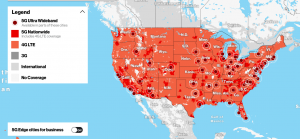
Aurora Insight provides business analytics for the entire wireless industry. Aurora Insight was launched when we recognized that 5G was going to be game changing. If you look at the evolution of global network technologies, about every decade a new ‘G’ is introduced, and each time a new ‘G’ comes out, it has a huge economic, social, and political impact. If you look back at the transition from 3G to 4G, it was evident that the US took a strong position and benefited greatly. When we think about the 5G roll out, which is much more complex than 4G, there is a pressing need to understand the radio frequency (RF) spectrum with more clarity.
Aurora Insight measures the RF environment with specialized sensors that are deployed on land, in the air, and even in space. Based on these measurements, we apply advanced processing to produce insights and solutions that solve challenges across the wireless industry. Our data is used by mobile network operators, wireless investors, tower companies and other infrastructure companies that use fiber, as well as wireless regulators and users.
When we first started the company, we didn’t intend to build our own partner network to sense the RF environment. However, we quickly found that there was not an existing sensor that was both performant enough and inexpensive enough to scale. We wanted sensors everywhere, and to do that the sensors need to be inexpensive and have key characteristics like wide bandwidth and high sensitivity, while still being resistant to RF impacts like saturation. That led to us developing our own sensor, which we now deploy in fixed locations, in aircraft, and on satellites. Eventually, our sensors will be everywhere — our very own, small inexpensive devices that can effectively monitor the RF environment.
We deploy the sensors in vehicles, by hiring drivers to drive around with the sensor. We can survey areas very densely, especially with millimeter wave deployments, which requires closer proximity for an accurate measurement.
Our sensor is also easily installed on light aircraft, which we fly over vast regions to get an overview of where wireless spectrum is in use, or where networks are being deployed in rural areas, small towns, or other locations that are just difficult to access — that might be mountainous, or with thick jungle vegetation.
And finally, we have three satellites in Low Earth Orbit, all of them operational. The satellites give us a global perspective on how the RF spectrum is being used over vast regions, and where networks are being deployed around the world.
Many sound policies have brought us to where we are today, but more bold action is needed to leverage commercial Space for national security, economic leadership, and environmental protection
Here’s an analogy to help explain it. When training a machine learning algorithm to identify a building, if you took a picture from the street level, you might see a door, windows and bricks. But, if you took an image from overhead, using an aircraft, you might just see a roof or a chimney. Those are two very different perspectives of the same exact building. So, you can imagine that in order to identify something as a building or a forest, you would need to take millions of photos of different types of buildings and trees to train your algorithm to detect whether these are buildings or trees. With the RF spectrum, it’s exactly the same. Aurora Insight had to collect and measure millions of data points to identify Long-Term Evolution (LTE), 5G, 3G, or Wi-Fi. We also needed to train our algorithms to see what those signals are. That is key to the uniqueness of our approach — aggregating all the data in the Cloud and having vast datasets to train these advanced algorithms.
Fundamentally, that comes down to the fact that radio frequencies only propagate so far from the source — the transmitter — and then deteriorate over distance. You can see this as you travel from cell to cell, you might lose coverage or maybe a Wi-Fi network. Location is important to establish a wireless network because you must design it to accommodate the different buildings or vegetation that might obstruct the signal’s propagation. This is especially true with millimeter wave 5G. Location becomes essential in establishing the infrastructure itself.
Location is also very important in spectrum management. There is always a geospatial element to spectrum use. Mapping, where certain types of signals or frequencies are present, is essential in being able to efficiently and effectively deploy spectrum for mobile network applications and other fixed wireless applications.
5G will be affected by geospatial technologies in ways that are similar to LTE and existing networks. If we look at the frequencies that are being used in 5G frequency range 1 (FR 1), they are similar to those being used by LTE, and the propagation characteristics, and coverage will be fairly similar because of the same frequencies being used. However, the real challenge comes in when we talk about implementing the ultrahigh-speed millimeter wave for 5G. They call this Frequency Range 2, or FR 2. Millimeter waves don’t propagate very far, and they are limited by obstructions. So, if you have a tree and there are no leaves on the tree, you can essentially transmit the millimeter wave through the empty branches and receive it at the other end. However, when that tree fills in, that signal will not penetrate those leaves, and you lose the connectivity for that user whose line of sight is now blocked. This makes it very important to understand the location sensitivities of the different technologies when designing networks.
Yes, China has the lead the way in 5G deployments in what’s called “mid-band” right now. There are a number of different areas where the US needs to change its approach to catch up. One of the areas involves policy and how the government can stimulate interest and evolution of 5G in the US. Spectrum is the natural resource on which all wireless communications are founded and making our mid-band spectrum available is critical.
In China, for example, bandwidth between 3 GHz and 4 GHz is widely used for 5G. But in the US, that band has traditionally been used for federal users and some satellite downlink. So the activity that the Federal Communications Commission (FCC) has been pursuing with the National Telecommunications and Information Administration (NTIA), has been to try to make this valuable mid-band spectrum more available to the mobile network industry. Another concern is the resiliency of the supply chain. With bans on Chinese manufactured 5G equipment, we have to figure out what we will do instead, and address how the US government can stimulate the whole 5G supply chain from semiconductors to devices and network equipment. That is another area where the US can make a large impact with new policies and different incentives for companies to build 5G.
That’s a hard question because there are now applications that we’d never thought of before 4G was available. There was a huge innovation movement after 4G started to become widely adopted. It is hard to predict what the new applications will be in totality, but I can say that there are a number of different industries that will be significantly affected by 5G. One of these is the healthcare industry.
Having access to highly reliable and low latency wireless infrastructure or wireless communication will greatly benefit remote healthcare. We talk a lot about autonomous vehicles, how those will be enabled and how you could reduce the number of traffic accidents ─ you could be more efficient in routing trucks, for example. Those are all enabled by reliable wireless connectivity. Another is manufacturing. If you have a 5G-enabled factory, you no longer need copper or fiber strewn throughout it. You could potentially have a more efficient operation; locating equipment or easily adding equipment without having to string all of this physical connection from point to point. There are many areas where 5G could make an impact. But, even being very creative in how we think about 5G being used, we will still miss certain applications. I expect we will be surprised at the new innovations that 5G will enable.
Spectrum is like land, it’s a natural resource, and we can’t make any more of it. There’s no spectrum for communication purposes that is currently not being used. So how do we efficiently and effectively use the spectrum? Right now, all over the world, spectrum is allocated to certain types of use ─ like satellite communications, mobile communications, or radiolocation. What we are seeing in the US is a challenge in 3 GHz to 4 GHz, where incumbent users may not be using the spectrum that is allocated to them continuously or over all geographies. Because of that, the US has made an effort to try to clear that spectrum or share the spectrum. This is just the tip of the iceberg as far as what needs to happen in the future. Both mobile network operators and military users want spectrum that is dedicated only to them. But there is not enough spectrum to go around, so we have to create an efficient way to share.
The digital divide is very real. Our economy is turning into a digital economy and those who are not able to connect to various digital resources are at a huge disadvantage. The pandemic has highlighted the digital divide, especially in underserved or underprivileged areas, and rural areas, where there wasn’t a strong demand for connectivity previously. One of the ways that Aurora Insight can help is by efficiently mapping network infrastructure in hard to reach places, vast rural areas, mountainous regions, or even continents, with our satellites. An important function of our company is to make that information available to help companies and governments plan better to serve their citizens or customers.
Women are underrepresented in science and technology, engineering, and mathematics. Industries across the board are missing out on a lot of talent, intelligence and creativity because of that. I’ve always been interested in science, which has made me a minority in the industry when it comes to gender. The way young girls are now interested in science, or participate in STEM activities, really amazes me.
My career has spanned almost 30 years; I’ve consistently been one of the very few women in a classroom, on a panel or in a meeting room. At times it has felt like something that works against me, but I’ve found that more often when I have an opportunity to speak or participate in something, I am perceived positively and because I am a woman, I bring a different perspective and have more presence on the floor.



Tableau has curated a number of visual tools with help of a community of experts ranging from local, regional to global and covering topics like COVID funding, meal resources, case
© Geospatial Media and Communications. All Rights Reserved.